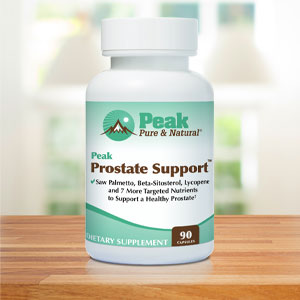Get Easy Health Digest™ in your inbox and don’t miss a thing when you subscribe today. Plus, get the free bonus report, Mother Nature’s Tips, Tricks and Remedies for Cholesterol, Blood Pressure & Blood Sugar as my way of saying welcome to the community!
Two of the simplest ways to lower blood pressure

Chronic high blood pressure, also known as hypertension, increases the risk of having a heart attack or stroke.
It can also lead to dementia, vision loss, bone loss, and kidney disease. That’s why it’s so important to take steps to lower blood pressure and keep it in a healthy range.
Medication can help, but simple changes to your diet can actually address the underlying causes of hypertension. That way you may be able to reduce your need for medication if you’re already on it — and maybe avoid it altogether if your numbers are just starting to creep up.
Considering that blood pressure medications have really come under fire by the FDA lately due to contamination with a known human carcinogen, there’s no better time to start lowering your blood pressure numbers naturally than now…
Increase your antioxidants and fiber
You see, blood pressure is determined by both the volume of blood your heart pumps, and the amount of resistance your arteries put up against that blood flow. A high volume of blood plus narrow, inflexible arteries, increases blood pressure numbers.
Cells in your arteries produce nitric oxide, which widens them so blood can flow through easily. But a buildup of free radicals — unstable molecules that disrupt healthy cells — stops this process. Without nitric oxide, arteries narrow and harden, increasing blood pressure.
Antioxidants from whole foods are your best defense against free radicals. Foods rich in nitrate help expand blood vessels. And studies show increasing fiber intake through cereals, grains and vegetables can reduce blood pressure.
To reduce hypertension, try adding these foods to your diet:
- Beans, peas, and lentils. They’re high in fiber and potassium, another heart-healthy nutrient
- Blueberries, which are high in antioxidants
- They have omega-3 fatty acids and antioxidants proven to reduce blood pressure
- Olive oil, with high levels of heart-healthy fats
- Pumpkin seeds (unsalted) and oil are high in fiber and magnesium
- Spinach, which is high in nitric oxide
- Beets are also high in nitric oxide
- Yogurt (unsweetened) has been shown to reduce blood pressure
Increasing the amount of these foods can help lower blood pressure. And, if you’re looking for a made-for-you blueprint on a diet to lower blood pressure, check out the DASH Diet.
The DASH diet
“DASH” is an acronym for Dietary Approaches to Stop Hypertension. This diet is made up of 8 to 10 servings of fruits and vegetables a day, whole grains, beans, nuts, low-fat dairy, lean meat like poultry or seafood, and healthy fats. It limits foods like red meat, added sugars, and unhealthy fats.
The DASH Diet, which is rich in antioxidants and fiber — including many of the foods I mentioned earlier — as well as potassium, magnesium, and nitric oxide, has been clinically shown to lower blood pressure in as little as one month.
However, researchers noticed that blood pressure numbers improved even more when this healthy diet was combined with a reduction in sodium.
Lower sodium intake
Too much salt can constrict blood vessels and increase blood volume, which, as noted above, is the exact cause of hypertension. Aim to keep your intake at 2,000 mg or less per day.
Reducing sodium intake means more than skipping the salt shaker. Even if you don’t salt your food, it’s likely you’re getting too much sodium because it’s hidden in just about every processed and packaged food product on the market — even those we think are healthy.
The American Heart Association has even created a list of foods with the highest amount of sodium, called “The Salty Six.” These are:
- Breads and rolls
- Pizza
- Sandwiches
- Cold cuts and cured meats
- Packaged soups
- Burritos and tacos
Try to avoid these foods, or opt for low-sodium versions wherever possible.
So, there are two simple things you can do to naturally lower your blood pressure and attack the root causes of the problem…
By following a healthy diet of whole foods rich in antioxidants and other nutrients, and reducing your sodium intake, you can lower your blood pressure (and your risk of heart attack, stroke, and kidney disease) and hopefully reduce your need for medication — with your doctor’s approval.
Editor’s note: Have you heard of EDTA chelation therapy? It was developed originally to remove lead and other contaminants, including heavy metals, from the body. Its uses now run the gamut from varicose veins to circulation. Click here to discover Chelation: Natural Miracle for Protecting Your Heart and Enhancing Your Health!
Sources:
- High blood pressure (hypertension) — Mayo Clinic
- Exploration of the Association between Dietary Fiber Intake and Hypertension among U.S. Adults Using 2017 American College of Cardiology/American Heart Association Blood Pressure Guidelines: NHANES 2007⁻2014 — JAMA Internal Medicine
- Flaxseed consumption may reduce blood pressure: a systematic review and meta-analysis of controlled trials — Journal of Nutrition
- Regular Yogurt Intake and Risk of Cardiovascular Disease Among Hypertensive Adults — American Journal of Hypertension
- Effects on Blood Pressure of Reduced Dietary Sodium and the Dietary Approaches to Stop Hypertension (DASH) Diet — The New England Journal of Medicine
- Salty Six Infographic — American Heart Association













